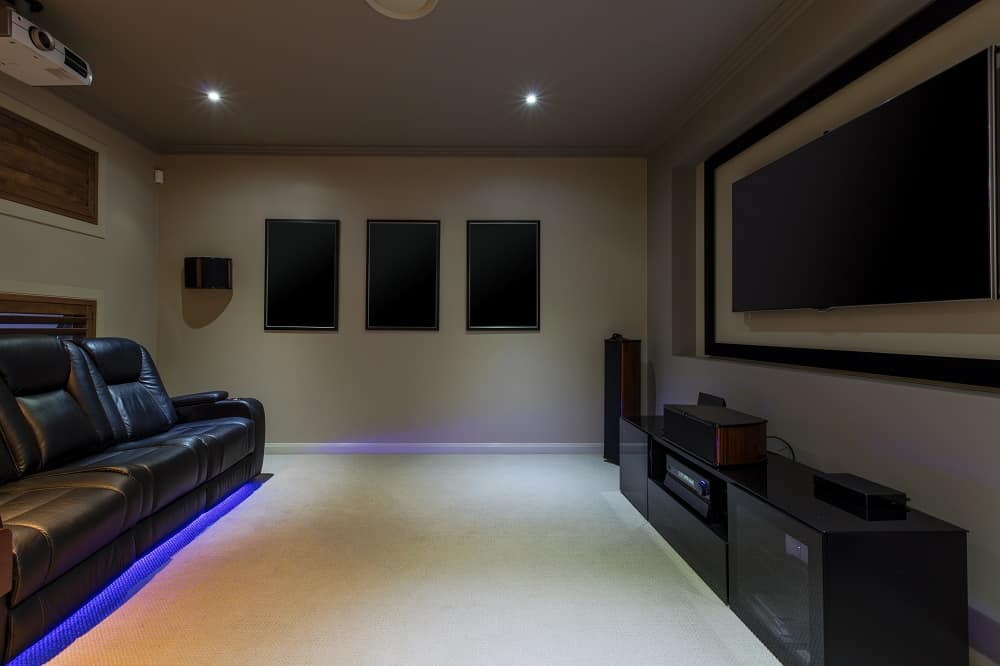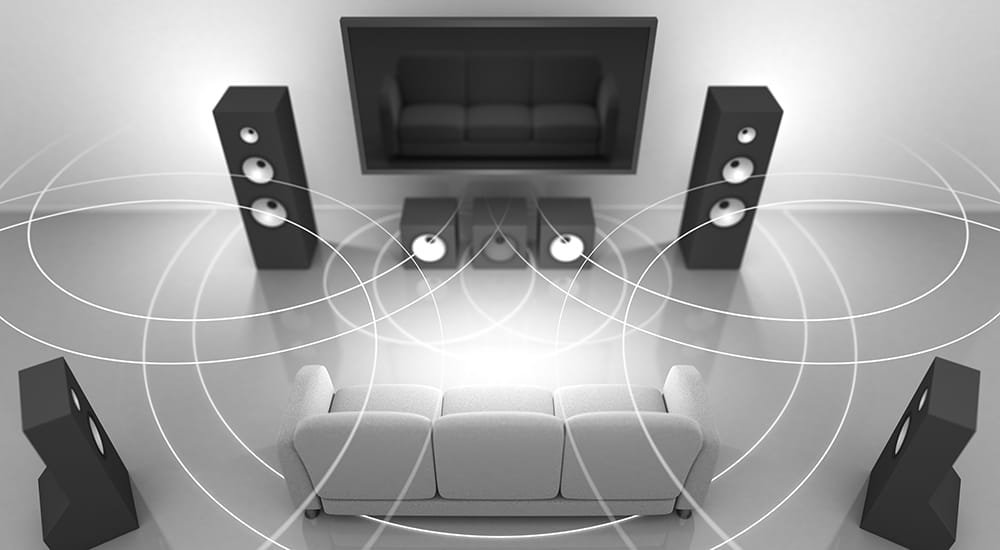A home movie theater has many facets that make it closely assimilate the full movie-going experience. One of the most important has to be the quality of the audio.
Having more speakers doesn't strictly mean better quality or louder sound. The type of speakers and their positioning is what achieves dynamic, movie theater realistic sound.
Surround sound and stereo sound are the most common formats within the entertainment industry. The best setup for your room depends on many factors.

Audio from a TV, radio, or through headphones is almost always stereo sound. It employs two speakers to playback the sound.
The best stereo sound setups also contain a subwoofer to reproduce the bass tones from the lowest ranges.
Up until the early 2000's it was the music and movie industry standard to use stereo sound in all productions.
Stereo sound is expansive. With additional speakers, amps, and subwoofers, the setup can grow exponentially in conjunction with your requirements.
As the name suggests, surround sound speaker systems offer the listener an immersive experience, whereby sound envelops and appears to come at them from every angle.
It's achieved by using multiple speakers, a minimum of 5. When correctly positioned and linked with one or several subwoofers, it creates an incredible depth of sound.
Surround sound is used in audio/visual situations as it reproduces directional sound.
Imagine, during a movie sequence, a person walks on crunchy gravel from one side of the screen to the other. Surround sound follows those footsteps across the screen, enabling the viewer to get a realistic sense of direction.
There is no competition; all home movie theaters should receive their audio through a surround sound system.

Most home theaters with average size rooms typically use a 5.1 system. Larger rooms benefit from the 7.1 system.
Learn More: The Difference Between 5.1 and 7.1 Surround Sound
The first number signifies the number of channels in the system, either 5 or 7, the second denotes the subwoofer in the chain.
There is an exact science to positioning the speakers to achieve overall audio excellence.
In the 5 speaker setup, the first speaker sits beneath the television or projector screen. Place one speaker to the left and the right of the seating area, and the final 2 in the front left and right corners of the room.
In the 7 speaker layout, the system is the same. The additional 2 speakers should be installed behind the rear seats, to fill the void where sound might otherwise be lost.
For the best results, audio experts suggest mounting these 2 speakers in the top corners of the room at a slight angle.
The setups above help to replicate the most accurate movie theater experience.
Effectively building a surround sound system can be daunting for the uninitiated.
That's where the home theater in a box system is beneficial. One handy box contains everything required to upgrade the sound from a TV or to connect to a projector for cinema-standard audio.
AV receiver with a built-in amplifier to receive, process, and boost the signal before it reaches the speakers is part of the kit. There are also 5 or 7 speakers, a subwoofer, and all of the relevant wirings. Finally, a remote to control the audio.
A kit supplied in its entirety comes with full installation and operation instructions.
Some people prefer to personalize their system by buying each component separately. For entry-level home theater constructors, a boxed set takes the guesswork out of which equipment to buy.
Each item is streamlined for use in small to medium-sized rooms and not take up too much space. It has no impact on their ability to produce powerful directional sound with much richness and depth.
Although kits can vary drastically in price, it is still most often the most affordable way of buying a surround sound system.
Amps and pre-amps are expensive pieces of equipment when separately purchased. The receiver in a full kit usually rules out the need for a pre-amp as it will already be built-in.
If you have already gone to great expense planning, designing, and building a home theater, then you will probably want the best surround sound system possible.
You can customize the look and the sound quality by purchasing each component separately and tailoring it to your exact requirements.
Most movies and games are formatted for surround sound; unlike TV shows. If you are buying speakers solely to enhance your TV program viewing experience, then stereo sound is the way to go.
Stereo is music's standard format. If your speaker system is solely to playback, mix, and listen to music, stereo sound is for you. Music is recorded in stereo and, therefore, formatted best for 2-channel output.
If the resulting sound isn't as deep or rich as you might prefer, it is easy enough to add a subwoofer into the audio chain.
Connecting stereo sound to a mixer allows the user to create more dynamic sounds with variable treble and bass.
If you're looking for a speaker system for a room that caters to both music and video entertainment, surround sound is the best option.
The system has a stereo setting to enable the sound to transmit through the front two channels. This involves processing the audio designed for two channels and dividing it amongst the additional ones in your particular setup.
Dolby Atmos uses modern technologies to play stereo music effectively through a surround sound system.
Although surround sound might not play music as well as a dedicated stereo system, the sound will still be of a high-quality. A good AV receiver and an amp will make up for any shortfall in audio clarity.
Modern-day, digitally processed music sounds better through surround sound than physical media such as vinyl and CD's does; for those stereo sound is always best.

We now know that surround sound requires multiple speakers, at least 5 plus a subwoofer.
In a relatively small room, don't be tempted to add extra speakers to gain volume; it won't work. In limited space, sound waves will randomly crossover each other, resulting in distortion.
It is hard to balance the number of speakers with room size. Err on the side of fewer speakers, upgrade with an additional subwoofer, or more speakers at a later date if required.
In larger rooms, any space behind the seating area tends to swallow up sound, creating a muffled effect. In this case, a 7.1 surround setup is advised, with the rear left and right corner speaker.
As a general rule of thumb, a 5.1 system is sufficient for rooms measuring 350ft° or less.
